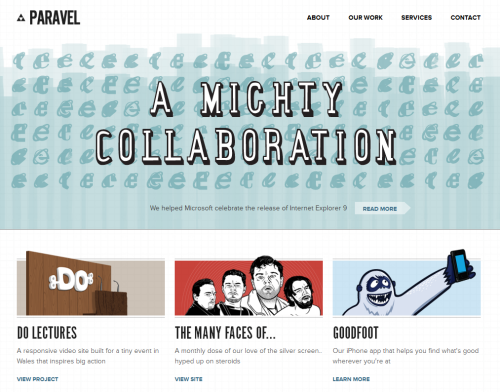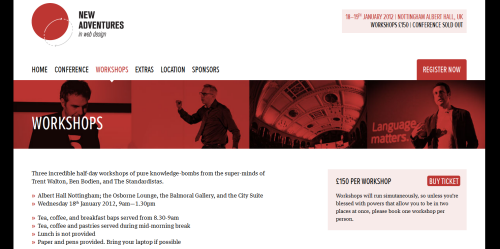We’re sponsoring New Adventures in Web Design, a UK based design conference, for the second year running. As part of the buzz surrounding the event, we’re interviewing the speakers to find out more about their backgrounds and motivation.
We asked designer and developer Trent Walton to tell us about his current projects and his involvement with NANCONF. There are still some spaces left for his workshop if you can make it to Nottingham in January!
Hi Trent, tell us a bit about yourself.
I’d been designing and building for the web in a side-project / freelance setting since 2001. Then, in 2005, I went to work for an industrial contractor, building websites for each of the affiliate companies. I learned a lot there and returned to 100% HTML and CSS layouts after a few years of working with Flash. When that job wrapped, I conspired with two of my friends, Dave Rupert and Reagan Ray, to form Paravel as a full-time web shop in 2007. We’d been collaborating on jobs for years and ultimately wanted to be in control of our own destinies & work environments.
You’re a designer, blogger, app creator and you’re running a workshop at NACONF – what are the benefits of being involved with so many things and how do you plan your time?
I’ve used things like side projects, writing for my blog, and presenting to help keep my skills sharp. Not all client gigs allow us to work with all the latest techniques, so blocking out time and prioritizing to-do lists so that I have the opportunity to experiment and learn is crucial. I believe that if I’m going to be of any value to clients tomorrow, I’ve got to always be looking beyond what is conventional today.
You founded and contribute to themanyfacesof.com. What inspired you to come up with the idea and how do you see it developing further in the future?
At Paravel, the most heated debates don’t always center around our work on the web, but around movies. The Many Faces Of started when I wanted to write an article about the great Alan Rickman, and commonalities I’d spotted in the way he plays villains. We were really amused by this and thought that an in-depth, infographic styled HTML & CSS blog post would be fun to create. We quickly realized we were going to want to do this again and again, so we pulled everything into WordPress and launched the site.
Our production pace has slowed lately, but we’ve got plans to build an addition to the site. I can’t say much about it just yet, but Reagan just finished the design, and we’re thrilled to get it into development very soon.
Paravel is a team effort. What are the pros and cons of running a design studio with other people?
I’ve been working with Dave Rupert and Reagan Ray for the past 10 years. Over time, we’ve grown to trust and respect each other a great deal. For me, this has created an ideal working environment where roles aren’t always clearly defined as founder, designer, and developer. Instead of passing off phases of a project to one another in a compartmentalized fashion, we throw everything out the table and slug it out. This ensures that our work isn’t the best any one of us can do, but that every project benefits from the sum of our own unique skill sets and perceptions.
I think what what I value most is the friendship that comes from running the business with these two. We get in tight spots and have to make tough decisions all the time, and I’m always more confident when we’ve talked things out and act on a consensus. For Paravel, 3 will never be a crowd.
What advice would you give to a web designer planning their design studio website?
Treat your portfolio as a set of case studies, not a gallery of screenshots. If you want to be hired to work with clients to think, solve problems, and innovate, make sure what you’re showing online reflects that. We started writing brief project summaries at https://paravelinc.com and at our own blogs when we finished jobs, and I believe it has helped us get involved in more and more interesting projects.
How did you get involved with NACONF and why did it appeal to you?
Last year Simon Collison asked me to design a page in the NACONF Paper. It was an honor to contribute, but I was sad when I had to miss out on attending the actual conference. I’ve followed and admired Simon’s work for years and after hearing about the topics he seeks to address each year at NACONF, I was both excited and humbled to be asked to speak this year. As our industry matures, we must be asking the right questions so that our way forward is intentional.
You’re running one of the workshops at NACONF, a new element for 2012. How hands-on will it be and what do you hope people will get from it?
Oh, it’ll definitely be hands on, but I like to over-prepare so that there can be a bit of improv. Sometimes there’s a lot of talent in the room and the most valuable thing you can have is a block of group discussion. I hope that attendees will be able take full advantage of web fonts on projects they’re working on now as well as be inspired to push the limits and innovate.
What are the benefits of incorporating a workshop element into a conference like NACONF?
The conversational and collaborative atmosphere that workshops lend themselves to is perfect for learning about practical application. Having that valuable time getting our hands dirty allows for more theoretical thinking on the following day when the speakers present.
Your workshop is based on typography, why did you choose this particular area of design?
When web fonts really caught on, I became inspired because many of the limitations we’d all become accustomed to were gone. If the quality in rendering is there, we can use any font on any site we want. When challenged with the front-end duties for Lost World’s Fairs with Dave Rupert, I was able to not only beef up my web type skills, but establish a philosophy for how best to push typography to the limits online.
What are your favourite online resources for designers?
99% of the time, my front-end woes have been solved over at https://css-tricks.com. I check https://dribbble.com daily and frequent the Typekit blog.



Comments
Please remember that all comments are moderated and any links you paste in your comment will remain as plain text. If your comment looks like spam it will be deleted. We're looking forward to answering your questions and hearing your comments and opinions!